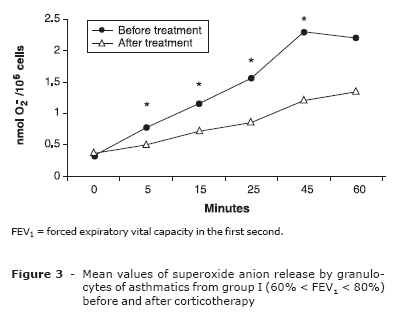OBJECTIVE: To evaluate spontaneous release of superoxide anion by peripheral blood granulocytes of atopic patients with uncontrolled asthma undergoing glucocorticoid therapy and of healthy subjects. METHODS: We studied 32 patients, aged 6 to 18 (mean 12.04), and 29 healthy subjects as a comparative group. Patients were grouped according to the forced expiratory vital capacity in the first second. Group I, forced expiratory vital capacity in the first second of between 60 and 80%, had 19 patients, and group II, forced expiratory vital capacity in the first second = 60%, had 13 patients. Spontaneous superoxide release by granulocytes was measured by a spectrophotometer method based on superoxide dismutase, before and after oral prednisone and beclomethasone, budesonide or fluticasone inhaled therapy. Statistical analyses were performed using ANOVA, Wilcoxon and Tukey tests. RESULTS: Comparing the superoxide anion release by granulocytes of asthmatic patients and healthy subjects, we observed a higher release by cells of the uncontrolled patient group II (p < 0.05). Evaluating the superoxide release by cells of asthmatic patients before and after steroid therapy, a significant decrease was found only in patient group I. CONCLUSION: The impact of corticosteroids on inflammatory modulation occurred in the uncontrolled asthmatics with forced expiratory vital capacity in the first second between 60 and 80%. In those with forced expiratory vital capacity in the first second of = 60%, this finding was not observed. Further studies are necessary to evaluate the effect of this finding on asthmatic patients.
Corticosteroids; superoxide radical; granulocytes; asthma; children; adolescents




